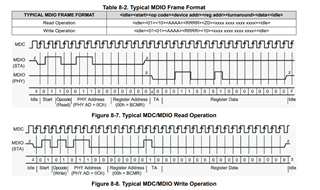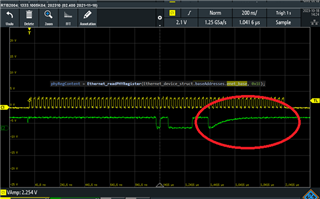Other Parts Discussed in Thread: TMS320F28388D
Hello,
Actually I'm using enet_lwip_udp and ethernet_c28x_config and working perfectly. I'd like to change functionality of LED_1 that is configurable and by default is not used.
Register of this led is 0x0460 and cofiguration I'd like is 0001 RX/TX Activity.
I've tried to check examples from Texas about accessing ENET registers and tried this commands:
Ethernet_device_struct.baseAddresses.enet_base = EMAC_BASE;
phyRegContent= HWREG(Ethernet_device_struct.baseAddresses.enet_base + 0x0460U);
phyRegContent= Ethernet_readPHYRegister(Ethernet_device_struct.baseAddresses.enet_base, 0x0460U);
When using HWREG i get 0x0000 when I'm using "Ethernet_readPHYRegister" I get 0xFFFF;
Actually I've tried to read other known addresses like 0x0000 to compare with datasheet default values, but no register that I read have a correspondence of values.
Using HWREG on other registers (0x0000, 0x0001, 0x0002 etc) I read "something" that doesn't correspond to datasheet default values, when I'm using "Ethernet_readPHYRegister" I get 0xFFFF any register I read.
What I'm missing?
MCU of reference is TMS320F28388D .







